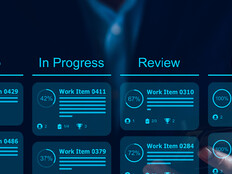A Network-Dependent Army
For today’s Army, every conflict includes offense, defense and stability (or peacekeeping) operations. It’s never one of these or another, says Gen. Pete Chiarelli, the Army’s vice chief of staff. All conflicts involve combinations of all three — changing dynamically in relative importance.
Working in such a constantly shifting environment makes it “crucial that we push the network down to the edge that the soldiers occupy,” says Chiarelli, who spoke via video conference from the Pentagon to a packed audience at the recent LandWarNet conference in Tampa.
Lt. Gen. Jeffrey Sorenson, CIO for the Army, adds that the service has essentially turned its approach to IT on its head. Based on the notions of Everything over IP and network dependence, the Army will migrate to an infrastructure in which 80 percent of IT services are based in the continental United States to support forward expeditionary forces worldwide. The first of these fully CONUS-supported brigade combat teams will deploy in fiscal 2011.
“We will operationalize this ability using the network service center concept,” Sorenson says. “This stuff is becoming real.”
The network has become the nexus of all that the service does when in theater and is critical to providing a common operating picture up and down the chain of command, Sorenson says. That requires unity of effort on systems architecture, testing, technology, acquisition and requirements, he says.
Achieving Agility
Chiarelli and Sorenson both agree that to maintain an agile Army that can use IT to the fullest extent requires changes in how technology makes its way from concept to spec, development, purchase and deployment.
“We have to put more advanced capabilities into the hands of our warfighters,” Chiarelli says. But the ability to keep pace has become harder and harder in recent years.
In part, that’s a process problem, he says, noting that there are 65 separate documents required to achieve 41 steps in the acquisition process. The result? A growing gap in innovation between commercial industry and the Defense Department.
The Army needs to integrate new technologies when it makes sense and in a timely way, Chiarelli says. “This is not about blowing out scope,” but about figuring out how to speed the process and integrate a growing breadth of technologies.
The timeline today for getting an IT system from concept to delivery is about 62 months — a lag that hinders the Army’s ability to meet the demands of users (both U.S. and allied forces) and combat an enemy whose ability to field technology is much swifter, Sorenson says.
Some parts of the Army have figured out how to do this in less than two years, he points out. In particular, he cites the Special Operations Command and the Joint Communications Support Element.
The trick, Sorenson says, is to define an enterprise architecture that shows how the service will use a capability and then expose that EA to industry so that tools arrive ready for integration and quick use. For both SOCOM and JCSE, such upfront efforts have radically reduced the lead time on IT projects, Sorenson says.
He intends for the rest of the service’s IT initiatives to follow a similar approach. The IT organization has launched a strategy for migrating to a standard operating environment that Sorenson says will make it much less complex to “infuse” hardware and software — both off-the-shelf products and homegrown applications such as those now being created by innovative service members through the Apps for the Army effort — into the network.
It’s fairly obvious, Chiarelli says: “We must fix our outdated process if we are to have any hope of keeping pace at all in this world. We need to do everything we can to avoid impeding progress ourselves.”








